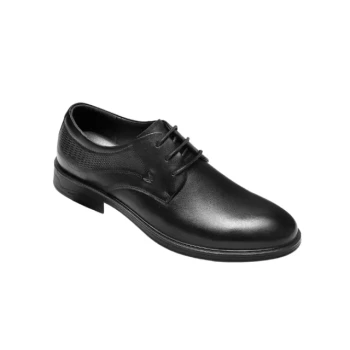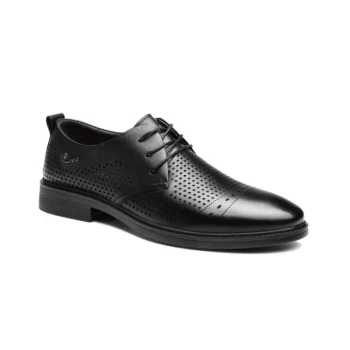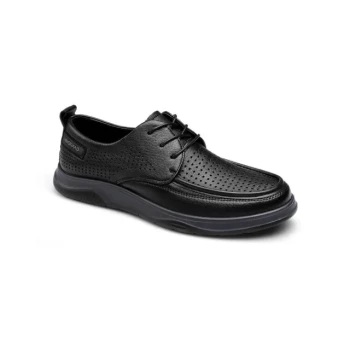Understanding different types of leather is crucial because it directly determines a shoe's durability, comfort, breathability, and how it will age. The term "leather" covers a wide spectrum of quality, and knowing the difference ensures you are making an informed investment, not just a purchase.
Your choice of leather is the single most important factor in a shoe's long-term value. It separates footwear that will last for decades from a pair that will disappoint you in a year.
The Hierarchy of Leather Quality
Not all leather is created equal. The part of the animal hide used and the way it's processed creates a clear hierarchy of quality, from the most natural and durable to the most processed and least resilient.
Full-Grain: The Gold Standard
Full-grain leather comes from the very top layer of the hide and includes all of the natural grain, with its inherent imperfections. This is the highest quality leather available.
Because the dense fiber structure is left intact, it is exceptionally strong, durable, and breathable. Over time, it develops a rich patina, a unique luster that makes the shoes look better with age.
Top-Grain: The Polished Performer
Top-grain leather is the second-highest quality. The very top surface of the hide is sanded or buffed to remove scars or branding marks, creating a more uniform appearance.
While still strong and durable, this process removes the strongest fibers, making it slightly less durable and breathable than full-grain. It is more resistant to stains than full-grain but will not develop the same beautiful patina.
Suede and Nubuck: The Velvet Touch
These leathers are known for their soft, napped finish. Nubuck is created by sanding the outer (grain side) of top-grain leather, while suede is made from the softer, inner split of the hide.
Both are very soft and comfortable but are also more porous and susceptible to stains and water damage. They require more diligent care and are best suited for less demanding environments.
Understanding the Trade-offs: Cost vs. Longevity
The type of leather used is a direct reflection of the shoe's intended price point and lifespan. Misleading terms are common, making it critical to understand what you are actually buying.
The "Genuine Leather" Deception
Despite its reassuring name, genuine leather is one of the lowest grades. It is typically made from the bottom layers of the hide or even from leftover scraps bonded together with glue.
Its surface is often painted or embossed with an artificial grain pattern to look like a higher-quality product. While very affordable, it lacks the strength, durability, and breathability of full-grain or top-grain leathers and will not stand up to heavy use.
The Impact on Breathability and Comfort
A key advantage of high-quality leather is its ability to breathe, which helps regulate temperature and moisture, keeping your feet comfortable.
Full-grain leather offers the best breathability. As you move to lower grades like genuine leather, which often has a synthetic coating, this breathability is almost entirely lost, leading to less comfort during extended wear.
The Realities of Maintenance
Premium leather is an investment that requires care. Conditioning high-quality leather keeps it supple and prevents cracking, ensuring it can last for many years.
Lower-grade leathers, on the other hand, do not benefit from conditioning in the same way and are more likely to peel or crack over time regardless of care. Suede and nubuck require specialized brushes and protectors to maintain their delicate surface.
Making the Right Choice for Your Needs
Selecting the right leather depends entirely on your priorities for the shoe.
- If your primary focus is maximum durability and longevity: Choose full-grain leather and commit to a regular cleaning and conditioning routine.
- If your primary focus is a polished, uniform look at a moderate price: Top-grain leather provides an excellent balance of quality, durability, and cost-effectiveness.
- If your primary focus is budget for occasional use: Genuine leather can suffice, but you must accept its significant limitations in durability and comfort.
- If your primary focus is a soft texture for specific styles: Suede or nubuck are beautiful choices, provided you are prepared for the necessary upkeep and avoid wet conditions.
Ultimately, choosing the right leather is not just a style choice; it's an investment in lasting quality and comfort.
Summary Table:
| Leather Type | Key Characteristics | Best For |
|---|---|---|
| Full-Grain | Highest durability, breathable, develops a patina | Maximum longevity & investment pieces |
| Top-Grain | Polished look, good durability, stain-resistant | Balanced quality & cost for everyday wear |
| Suede/Nubuck | Soft, napped finish, stylish | Fashion-forward styles in dry conditions |
| Genuine Leather | Affordable, often coated or embossed | Budget-conscious, occasional use |
Ready to source high-quality footwear built with the right leather for your market?
As a large-scale manufacturer, 3515 produces a comprehensive range of durable and comfortable shoes and boots for distributors, brand owners, and bulk clients. We expertly work with all leather types to ensure your products meet the highest standards of quality and value.
Contact our team today to discuss your production needs and get a quote.
Related Products
- Custom Manufactured Air Cushion Leather Business Shoes for Wholesale
- Factory Direct Wholesale Leather Comfort Shoes with Dial Closure
- Wholesale Leather Derby Shoes Manufacturer | Customizable Business & Dress Footwear
- Classic Leather Derby Dress Shoes Wholesale & Custom Manufacturing
- Wholesale Leather Business Casual Shoes with Dial Closure - Manufacturer of Comfort Dress Sneakers
People Also Ask
- Can trainers/sneakers be worn in a business casual setting? How to Choose the Right Style for a Professional Look
- Can sneakers be part of a business casual wardrobe? Yes, with the right style and fit
- Are sneakers appropriate for business casual settings? A Guide to Modern Office Footwear
- How does leather compare to other shoe materials in terms of durability and comfort? A Material Guide for Footwear
- Are sneakers acceptable in a business casual workplace? How to Choose the Right Style



















